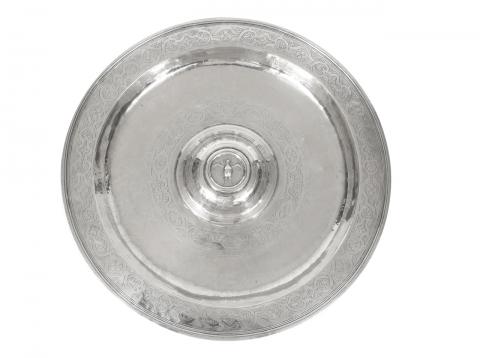Bacia
Basin
Silver
Portugal, late 16th century
Diameter: 43.0 cm
Weight: 1578.0 g
Bacia
Prata
Portugal, finais do século XVI
Diam.: 43,0 cm
Peso: 1578,0 g
This basin, crafted in Portuguese silver during the late 16th century, features a later central medallion bearing the Holy Spirit.
The piece boasts a raised and fluted rim, and its border exhibits a combination of geometric (ferroneries reminiscent of Mannerist ironwork) and phytomorphic motifs, resulting in an intricate decoration.
The mostly smooth centre of the basin has a chisel-decorated band around the central medallion, echoing the decorative pattern of the border. The finely carved decoration likely draws inspiration from contemporary printed sources. The raised central medallion, surrounded by a geometric incised decoration, prominently features the later chiselled and repoussé image of the Holy Spirit.
Smooth basins revealing engraved or incised rims, often incorporating central medallions, constitute the most common models of national production from the 15th and 16th centuries. In the 16th century, noteworthy basins of significant size, including the one under examination, emerged, along with a noticeable uptick in the use of phytomorphic decoration in Portuguese production. The scarcity of surviving examples emphasizes the significance of the remaining pieces.
The earliest mention of Portuguese silver marking was documented in December 1401, in a statute issued in the city of Oporto (António Cruz 1984-1986). Nevertheless, between the last quarter of the 16th century and the third quarter of the 17th century, during the period of Dynastic Union between the Portuguese and Spanish Crowns (1580-1640) and the ensuing Independence Wars, there were no official hallmarks. It was only in 1668, in the reign of King Pedro II, that silver and gold hallmarking returned, with the publication of the regulations that delivered the re-establishing of the various municipal stamps.
Being a work with characteristics from the second half of the 16th century, the fact that it is not marked could be an indication that it was executed in the last quarter of this century.
The basin has, however, the Lisbon mark of «gold or silver (used)» artefacts, regularly known «cabeça de velho» (old man's head), used between 1938 and 1985, with the aim of guaranteeing the kind and fineness of the precious metal.
Marta Silva Pereira
Bibliografia:
Fernando Moitinho de Almeida, Marcas de Pratas Portuguesas e Brasileiras (Século XV a 1887), Lisboa: IN-CM, 2018
Guedes, Natália Correia, Roteiro de Ourivesaria, Lisboa: MNAA, 1975
Silva, Nuno Vassalo e, Ourivesaria Portuguesa de Aparato, Séculos XV e XVI, Lisboa: Scribe, 2012
Bacia redonda em prata portuguesa, ostentando o Espírito Santo, posteriormente repuxado e cinzelado, no seu medalhão central.
De bordo levantado e estriado, a aba é trabalhada por motivos tanto geometrizantes (ferroneries tipicamente maneiristas) como fitomórficos, que se combinam numa intricada decoração.
O covo é maioritariamente liso, com banda cinzelada pela frente ao torno do medalhão central, seguindo o registo decorativo da aba. Finamente entalhada, a decoração será possivelmente modelada a partir de fontes impressas contemporâneas.
No medalhão central alteado, circundado por decoração incisa geométrica, enfatizando a imagem central da peça, destaca-se a pomba do Espírito Santo cinzelada e repuxada posteriormente.
Bacias lisas revelando abas adornadas de gravados ou relevados, frequentemente apresentando medalhões centrais, constituem os modelos mais comuns da produção nacional dos séculos XV e XVI. Já no século XVI destacam-se um conjunto de bacias de consideráveis dimensões como o exemplar em análise, assim como um incremento da decoração fitomórfica na produção portuguesa. Contudo, poucos exemplares sobreviveram, evidenciando a importância das peças sobreviventes .
A mais antiga referência a «marcas» portuguesas para prata foi documentada em dezembro de 1401, num regimento da Cidade do Porto (António Cruz 1984-1986). Todavia, desde o último quartel do século XVI - durante a dinastia filipina e até ao terceiro quartel do século XVII - não foi utilizada qualquer punção oficial . Somente a partir de 1668, durante o reinado de Pedro II, se restabeleceu a marcação da ourivesaria em Portugal, com o decreto de regimentos que proporcionou o renascer de diferentes marcas municipais.
Sendo um trabalho com características da segunda metade do século XVI, o facto de não se encontrar marcada poderá ser indicativa de ter sido executada no último quartel desta centúria.
A bacia tem, contudo, a marca de Lisboa de «ouro ou prata (usado)» para artefactos, usualmente designada por «cabeça de velho», utilizada entre 1938 e 1985, com o objetivo de garantir a espécie e o toque do metal.
Marta Silva Pereira
Bibliografia:
Fernando Moitinho de Almeida, Marcas de Pratas Portuguesas e Brasileiras (Século XV a 1887), Lisboa: IN-CM, 2018
Guedes, Natália Correia, Roteiro de Ourivesaria, Lisboa: MNAA, 1975
Silva, Nuno Vassalo e, Ourivesaria Portuguesa de Aparato, Séculos XV e XVI, Lisboa: Scribe, 2012
- Arte Portuguesa e Europeia
- Pratas

